F-8 History
In September 1952 the US Navy issued a required for a fighter that could fly faster than the speed of sound and operate from a carrier. The RFP (Request For Proposals) was issued to eight different aircraft manufacturers. A total of 21 proposals were submitted. In May 1953 the US Navy selected the V-383 by Chance-Vought as the winner. Two prototypes were built and designated XF8U-1. Shortly after the US Navy also ordered the V-392 which would become known as the F8U-1P.
On March 25 in 1955 the first prototype took off from Edwards AFB for its maiden flight. On this first flight the aircraft went supersonic. Shortly after the production of the F8U-1 started. The first F8U-1P flew on December 17, 1956 and it was the F8U-1P that did low-level photo reconnaissance during the Cuba crisis, The F8U-1 was followed by an improved variant, the F8U-1E, which had an improved radar system (and so a bigger radome), giving it limited all-weather capability. The first F8U-1E - a modified production F8U-1 - flew in early September, 1958 A total of 218 F8U-1s and 130 F8U-1Es were built before production switched in September of 1958 to the F8U-2.
The YF8U-2 prototype flew for the first time on August 20, 1957. It was powered by a new and more powerful engine, a J57-P-16 with afterburner. The new engines also needed additional cooling. The F8U-2 could be fitted with up to four instead of two Sidewinder missiles. However, the four-missile armament was only very rarely carried in combat, since pilots felt that the extra weight and reduction in fuel load was not worth the two extra missiles. The F8U-2N was a limited all-weather interceptor version of the Crusader. The 'N' stood for night, because this version was intended to become a true night fighter. It was equipped with the even more powerful J57-P-20 engine and an approach power compensator (APC). The APC made the carrier landings a lot easier and saver. A total of 152 were built between June 1960 to January 1962 and served also with the US Marine Corps. The US Navy F-8D's were however quickly replaced by the F-8E.
On September 18, 1962, the Crusader F8U was re-designated F-8 under the new unified Tri-Service designation scheme.
The F8U-2NE or later designated F-8E was the final production version of the Crusader for the US Navy. It was an improvement of the F8U-2N with a new and even larger APQ-94 search and fire-control radar that gave it improved all-weather capability. The F8U-2NE differed from previous Crusaders in having a substantial air-to-ground capability. A total of 286 F-8Es were built until the end of the summer of 1964. It was the E model of the Crusader that was responsible for the greatest number of Crusader MiG kills in Vietnam
The F8U-1T (TF-8A) was a two-seat version of the original F8U-1. Although it seemed promising during 1962 it never went into full scale production because of US Navy cutbacks. The TF-8A went to Europe to attract customers, the British were at first interested but choose the F-4 Phantom. The TF-8A was sold to NASA and later regained to train Philippine pilots.
The US Navy chose to retain its smaller carriers, not capable of carrying the much bigger F-4 Phantom. Therefore a general Crusader Upgrade Program was issued.
The RF-8G was a refurbished RF-8A with a modern engine. The first RF-8G re-entered service in October of 1965. Lifetime of these RF-8G photo recce crusader proved to be much longer than anticipated and in 1977 a second upgrade was done. The RF-8G remained in service with the US Navy till 1986 and thereby was the latest and longest serving Crusader in the US Navy. Starting in 1967 the F-8Ds were converted to the F-8H with a new engine. F-8Es were re-manufactured as F-8J. The F-8J was the last Crusader fighter to take part in the Vietnam War. The next step was to upgrade the F-8Bs to F-8K and the F-8Cs to F-8L standards. The F-8M was supposed to be the designation for F-8As with low fly time, but there were not enough F-8A.
History: French service
In 1962 the French Navy (Marine Nationale) ordered the F-8 Crusader to serve as the AĆ©ronavale air superiority fighter from its new carriers Clemmenceau and Foch. The F-8E required modifications in order to make it suitable and safe for the smaller French carriers. Improvements such as a bigger maximum angle of incidence for the wing to further reduce the landing speed were necessary. A new weapon system was installed to make it capable for the French R.530 Matra missile. The variant was designated F-8E(FN) and entered service in October 1964. The French Crusader saw multiple upgrade (wings, afterburner and the R.550 Magic missile) until it was finally replaced in December 1999. When the carrier Clemmenceau was sent to the Persian Gulf during the Gulf War of 1990-1991, the Crusader was tasked with carrier protection against potential attacks from small vessels.
History: Philippine service
In late 1977, the Philippines government purchased 35 ex-US Navy F-8Hs that had stored at Davis-Monthan AFB in Arizona. 25 of them were refurbished by Vought and the remaining ten were used for spare parts. As part of the deal the US would train Philippine pilots using the TF-8A. In 1988, after having intercepted a large number of Soviet bombers, all were withdrawn from service.
Primary source: Joe Baugher's Aviation Directory
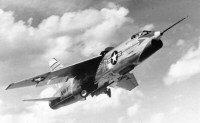
XF8U-1 prototype
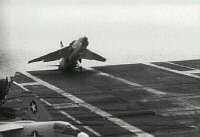
APC was installed to prevent this
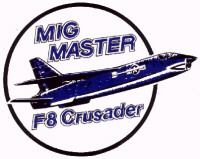
Many MiG kills over Vietnam
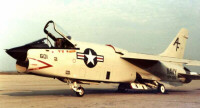
RF-8G recce
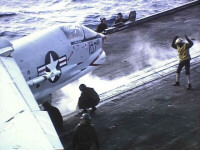
On the cat
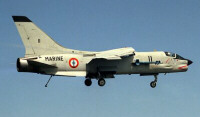
French Naval F-8E(FN)
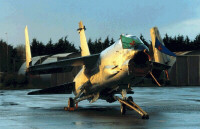
Last F-8E(FN) parked for the last time
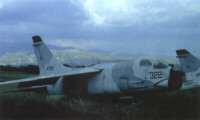
Philippines' F-8H


 Back to Index
Back to Index